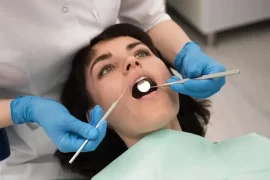A beautiful smile is often the result of aligned, healthy teeth. However, over time, teeth shifting can occur due to various factors, leading to misalignment and potential oral health issues. Preventing teeth shifting involves understanding the causes, adopting proactive strategies, and seeking professional guidance to maintain a straight and healthy smile. Let’s explore effective preventive measures and strategies to thwart teeth shifting and preserve a well-aligned dentition.
Understanding Teeth Shifting
1. Causes of Teeth Shifting
Teeth shifting can result from multiple factors, including aging, genetics, inadequate dental care, wisdom tooth eruption, teeth grinding (bruxism), gum disease, and missing teeth.
2. Consequences of Misaligned Teeth
Misaligned teeth not only affect aesthetics but also impact oral health, leading to difficulties in cleaning, increased risk of decay, gum problems, and potential jaw issues.
3. Teeth Replacement Options
If missing teeth are causing your teeth to shift, one effective remedy is teeth replacement. In Midland, Texas, you can find an array of options to address teeth replacements. Dental implants, bridges, partial dentures, and complete dentures are all viable options, depending on the extent of tooth loss.

These replacements not only fill the gaps but also provide a structure that prevents the adjacent teeth from moving.
Effective Strategies to Prevent Teeth Shifting
1. Maintain Consistent Oral Hygiene
Regular brushing and flossing are essential to prevent plaque buildup, gum disease, and decay, which can contribute to teeth shifting.
2. Use a Mouthguard for Bruxism
Wearing a custom-made mouthguard at night helps protect teeth from the effects of bruxism, reducing the risk of teeth shifting due to grinding.
3. Address Missing Teeth Promptly
Replace missing teeth promptly with implants, bridges, or dentures to prevent neighboring teeth from shifting into the gaps, causing misalignment.
4. Regular Dental Check-ups
Frequent dental visits allow for early detection of issues that may lead to teeth shifting, enabling prompt intervention and preventive measures.
5. Orthodontic Retainers
Wearing retainers after orthodontic treatment helps maintain the position of teeth and prevents shifting, as teeth tend to move naturally after braces are removed.
Lifestyle Practices for Preventing Teeth Shifting
1. Avoid Teeth-Inducing Habits
Avoid habits like nail-biting, using teeth as tools, or biting on hard objects, which can exert pressure on teeth and contribute to shifting.
2. Healthy Dietary Choices
Consume a balanced diet, limiting sugary foods and acidic beverages that can contribute to tooth decay and weaken enamel, potentially leading to teeth shifting.
3. Quit Smoking
Smoking not only impacts oral health but also affects gum health, potentially leading to gum disease and teeth shifting. Quitting smoking contributes to overall oral health.
Early Intervention for Preventing Teeth Shifting
1. Early Orthodontic Treatment
Address orthodontic issues early in childhood to prevent severe misalignments that may cause teeth shifting later in life.
2. Prompt Gum Disease Treatment
Treat gum disease early to prevent bone loss and gum recession, which can lead to teeth becoming loose and shifting position.
3. Wisdom Tooth Management
Monitor the eruption of wisdom teeth and seek professional advice for extraction if they pose a risk of causing teeth crowding or misalignment.
Importance of Professional Guidance
1. Customized Treatment Plans
Consult with dental professionals to develop personalized plans tailored to individual oral health needs and address concerns about teeth shifting.
2. Orthodontic Assessment
Regular orthodontic assessments in children and adolescents help identify potential issues and prevent severe misalignments before they progress.
Additional Strategies for Preventing Teeth Shifting
1. Wear Your Retainers
Follow orthodontists’ instructions to wear retainers consistently after completing orthodontic treatment to maintain teeth alignment.
2. Maintain Good Posture
Poor posture can affect jaw alignment and tooth positioning. Be mindful of posture to reduce the risk of jaw misalignment and teeth shifting.
The Role of Orthodontic Treatments in Preventing Shifting
1. Braces or Aligners
Orthodontic treatments like braces or aligners correct misalignments, preventing teeth shifting and improving overall oral health.
2. Orthodontic Evaluation in Adulthood
Even in adulthood, seeking orthodontic evaluation and treatment can prevent further teeth shifting and address existing misalignments.
Emphasizing the Importance of Consistency
1. Regular Maintenance
Consistency in maintaining good oral hygiene practices, visiting dentists, and following orthodontic recommendations is crucial for preventing teeth shifting.
2. Educational Support
Educational resources and guidance from dental professionals support individuals in maintaining consistent oral health habits to prevent teeth shifting.
Preventing teeth shifting involves a combination of proactive strategies, lifestyle practices, and professional guidance aimed at maintaining proper alignment and oral health. By adopting consistent oral hygiene habits, addressing dental issues promptly, seeking professional intervention, and considering orthodontic treatments when necessary, individuals can safeguard their smiles against misalignments and potential oral health complications. Remember, proactive measures and a commitment to oral health play pivotal roles in preserving a straight and healthy smile that lasts a lifetime.







